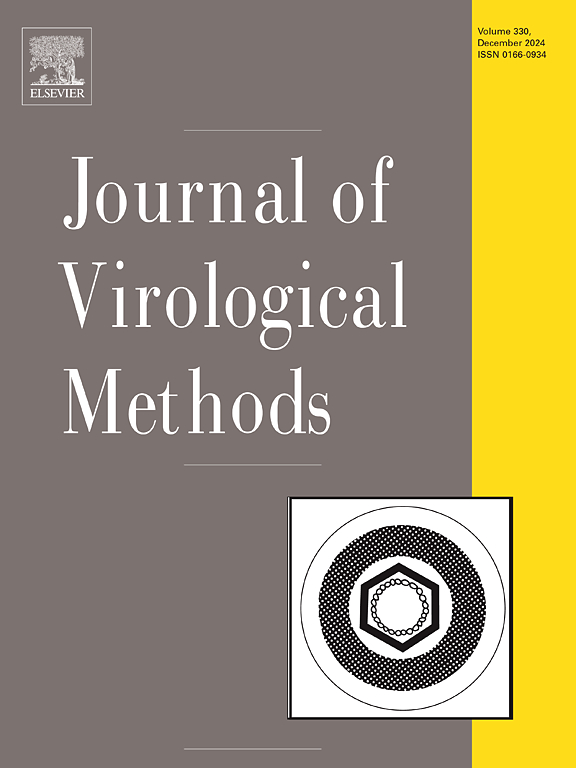建立一种快速鉴定MPXV及其Ia、Ib、IIa和IIb支系的arms -四重qpcr方法
IF 2.2
4区 医学
Q3 BIOCHEMICAL RESEARCH METHODS
引用次数: 0
摘要
猴痘在2022年再次出现,并蔓延到100多个国家。猴痘病毒(MPXV)的两个分支导致不同的致死率和不同的传播能力。快速鉴定MPXV及其分支和亚分支的分化是有效控制该疾病的关键。在本研究中,我们建立了一种arms - four - plex- qpcr方法来检测MPXV并区分进化支(Ia, Ib, IIa和IIb)。F3L基因用于检测MPXV与其他正痘病毒的所有分支。含有C3L基因的1953年 bp片段被发现在进化枝II中完全缺失。另外,Ib中缺失了1953 bp片段中第177 ~ 1318位(1142 bp)的序列,因此,我们用这1142 bp的序列来区分Ia和其他亚支系,用Ib中缺失的1142 bp的序列来区分Ib和其他亚支系。由于亚支系IIa和IIb太接近而没有大的缺失和插入,因此使用独特的单核苷酸多态性(SNP)设计ARMS-qPCR的引物/探针集来区分分支IIa和IIb。arms - four - plex- qpcr系统可以检测到MPXV每个反应的2个拷贝,并有效区分所有四个亚支系。总共在一个试管中部署了四个qPCR引物/探针集来识别MPXV并区分MPXV亚支系。该系统的高灵敏度、快速和特异性使其成为MPXV诊断和确定感染MPXV亚支系的一种有希望的替代方法。本文章由计算机程序翻译,如有差异,请以英文原文为准。
Development of an ARMS-Quadruplex-qPCR assay for the rapid identification of MPXV and the clades Ia, Ib, IIa and IIb
Monkeypox was re-emerging in 2022 and spread to more than 100 countries. Two clades of Monkeypox virus (MPXV) result in different lethality rates and varying transmission capabilities. Rapid identification of MPXV and differentiation of its clades and subclades are crucial for effective control of the disease. In this study, we developed an ARMS-Quadruplex-qPCR method to detect MPXV and distinguish clades (Ia, Ib, IIa and IIb). F3L gene was used to detect all clades of MPXV from other orthopoxviruses. A 1953 bp fragment containing the C3L gene was found to be completely absent in clade II. Additionally, a sequence spanning from the 177th to the 1318th position (1142 bp) within the 1953 bp fragment was missing in Ib. Therefore, the 1142 bp sequence was used to distinguish Ia from other subclades, and the sequence with the 1142 bp region missing in Ib was used to discriminate Ib from other subclades. Since subclades IIa and IIb are too close to have large deletions and insertions, a unique single nucleotide polymorphism (SNP) was used to design a primer/probe set for ARMS-qPCR to differentiate clade IIa from IIb. The ARMS-Quadruplex-qPCR system can detect down to 2 copies per reaction of MPXV and effectively differentiate all the four subclades. Altogether, four qPCR primer/probe sets in one tube were deployed to recognize MPXV and differentiate MPXV subclades. The high sensitivity, rapidity and specificity of the developed system make it a promising alternative for the diagnosis of MPXV and the determination of the subclades of the infected MPXV.
求助全文
通过发布文献求助,成功后即可免费获取论文全文。
去求助
来源期刊
CiteScore
5.80
自引率
0.00%
发文量
209
审稿时长
41 days
期刊介绍:
The Journal of Virological Methods focuses on original, high quality research papers that describe novel and comprehensively tested methods which enhance human, animal, plant, bacterial or environmental virology and prions research and discovery.
The methods may include, but not limited to, the study of:
Viral components and morphology-
Virus isolation, propagation and development of viral vectors-
Viral pathogenesis, oncogenesis, vaccines and antivirals-
Virus replication, host-pathogen interactions and responses-
Virus transmission, prevention, control and treatment-
Viral metagenomics and virome-
Virus ecology, adaption and evolution-
Applied virology such as nanotechnology-
Viral diagnosis with novelty and comprehensive evaluation.
We seek articles, systematic reviews, meta-analyses and laboratory protocols that include comprehensive technical details with statistical confirmations that provide validations against current best practice, international standards or quality assurance programs and which advance knowledge in virology leading to improved medical, veterinary or agricultural practices and management.

 求助内容:
求助内容: 应助结果提醒方式:
应助结果提醒方式:


